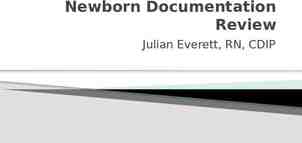Chapter 4-1
41 Slides837.50 KB
Chapter 4-1
Chapter 4 Accounting Information Systems and Business Processes: Part I Introduction Business Process Fundamentals Collecting and Reporting Accounting Information Two Core Business Processes Business Processes and Businesses-WithoutBoundaries Chapter 4-2
Introduction AISs depend on the flow of data through various organizational subsystems Effective processing systems ensure capture of appropriate data and accurate information Transaction processing cycles Chapter 4-3 organize transactions related to an organization’s business processes.
Business Process Fundamentals The accounting cycle Analysis of a transaction from a source document. A source document records a business activity such as the purchase or sale of goods, can be a piece of paper, or can be in electronic form. Chapter 4-4
Journals The journal is a chronological record of business events by account. Account structure of an organization is its chart of accounts. may be a general journal or a special journal a general journal allows any type of accounting transaction to be recorded, a special journal captures specific types of transactions. Chapter 4-5
Special Journals for AISs Sales Journal Record of credit sales transactions Purchases Journal Record of credit purchase transactions Cash Receipts Journal Record of transactions involving receipts of cash Cash Disbursements Journal Chapter 4-6 Record of transactions involving disbursements of cash
Ledgers Ledger general ledger contains detailed monetary information about an organization’s assets, liabilities, revenues, and expenses. subsidiary ledger Chapter 4-7 contains detailed records pertaining to a particular account in the general ledger.
Trial Balances AIS records journal entries posts them to the general ledger, the system creates a trial balance. Three end of period trial balances: Chapter 4-8 A preadjusting trial balance after all entries have been posted; An adjusted trial balance after adjustments have been recorded and posted; A postclosing trial balance after closing entries have been recorded and posted.
Steps in the accounting cycle Chapter 4-9
Financial Statements Financial statements are the primary output of a financial accounting system include the following statements: Income Statement Statement of Owners’ Equity Balance Sheet Cash Flow Statement Chapter 4-10
BUSINESS PROCESS FUNDAMENTALS Which of the following provides the organizational structure for the general ledger? a. Special journals. b. A source document. c. General Journals. d. The chart of accounts. Chapter 4-11
Coding Systems AISs depend on coding to record, store, classify and retrieve financial data. Computer codes for processing accounting transactions are Chapter 4-12 numeric or alphanumeric codes
Coding Systems Codes are necessary to Chapter 4-13 Uniquely identify transactions and accounts Compress data Aid in classification of accounts or transactions Communicate special meaning
Types of Codes Mnemonic Codes give visible clues concerning the objects they represent. Sequence Codes assign numbers or letters in consecutive order. Block Codes are sequential codes in which specific blocks of numbers are reserved for particular uses. Group Codes Chapter 4-14 combining of two or more subcodes.
Design Considerations in Coding Codes should serve some useful purpose. should be consistent. should plan for future expansion. Chapter 4-15
Collecting and Reporting Accounting Information The design of an AIS should be effective consider outputs from the system. Outputs of an AIS include: Chapter 4-16 reports to management reports to investors and creditors files that retain transaction data files that retain current data about accounts
Considerations in Report Design Reports should be useful for managerial decisionmaking, should not create information overload. Format of the reports should contain fundamental identification, be convenient, and be consistent. Reports that only list exceptional Chapter conditions are exception reports. 4-17
Collecting the Data for Output Reports Source Documents help manage the flow of accounting data by dictating the kinds of data to be collected and help ensure legibility, consistency, and accuracy in recording data encourage the completeness of accounting data serve as distributors of information for individuals or departments. Chapter 4-18
Collecting the Data for Output Reports help to establish the authenticity of accounting data in Chapter 4-19 establishing an audit trail, testing for authorization of cash disbursement checks testing for inventory disbursements, and establishing accountability for the collection or distribution of money.
Core Business Processes An AIS collects and reports data related to business processes which are collections of activities that create value. An economic event is an economic activity impacts financial statements (accounting transactions). A business event Chapter 4-20 is important to the business, does not impact financial statements.
Core Business Processes What is (are) a collection of activities or flow of work in an organization that creates value? a. An economic event. b. An accounting transaction. c. A business process. d. A chart of accounts. Chapter 4-21
The Sales Process The sales process begins with a customer order for goods or services and ends with the collection of cash from the customer. The primary objective is to achieve timely and efficient revenue collection. An organization that generates revenues, but fails to collect these revenues on a timely basis, may find itself in a position where it cannot pay its bills. Chapter 4-22
Objectives of the Sales Process Tracking sales of goods and/or services to customers Filling customer orders Billing customers for goods and services Collecting payment for goods and services Forecasting sales and cash receipts Chapter 4-23
The Sales Process - Inputs Sales Order Prenumbered, usually prepared in multiple copies, and used to prepare sales invoice Sales Invoice prepared after shipment of goods or providing of a service Remittance Advice served as source document for credits to accounts receivable Chapter 4-24
The Sales Process - Inputs Shipping Notice prepared after goods are released for shipment, and may serve as a packing slip Debit/Credit memo issued for sales returns and allowances; debit memos increase amount customer owes Chapter 4-25
The Sales Process Outputs Financial Statement Information Customer Billing Statement includes sales, returns, and cash receipts Accounts Receivable Aging Report Chapter 4-26 contains data concerning the status of open balances of all active credit customers arranges the overdue amounts by time periods
The Sales Process Outputs Bad Debt Report contains info about collection follow-up procedures for overdue customer accounts Cash Receipts Forecast Chapter 4-27 data from source documents in revenue transactions are inputs
The Sales Process Outputs Approved Customer Listing list of customer codes, contacts, shipping and billing addresses, credit limits, and billing terms Sales Analysis Reports Chapter 4-28 detailed data about each sale in order to monitor sales activities and plan production and marketing efforts
The Purchasing Process The purchasing process begins with a request for goods or services and ends with the payment of cash to the vendor. Purchase may be for either goods or services Purchase can be by cash or on credit Chapter 4-29
Purchasing Process Objectives Tracking purchases of goods and/or services from vendors Tracking amounts owed Maintaining vendor records Controlling inventory Making timely and accurate vendor payments Forecasting purchases and cash outflows Chapter 4-30
Purchasing Process - Inputs Purchase Requisition shows items requested by stores, indicates names of vendors Purchase Order is based on purchase requisition including vendor information Vendor Invoice includes prices, shipping terms and discounts Receiving Report reflects the count and condition of goods received Chapter 4-31
Purchasing Process - Inputs Bill of lading accompanies the goods sent and given by the freight carrier to the supplier as a receipt. Packing slip indicates the specific quantities and items in the shipment and those items that are on back order. It is sometimes included in the merchandise package. Debit/Credit Memoranda debits or credits accounts payable. Chapter 4-32
Purchasing Process Outputs Financial Statement Information Vendor Checks supported by a voucher and signed by a person designated by management Check Register Chapter 4-33 list of all checks issued for a particular period
Purchasing Process Outputs Discrepancy Reports used to identify any differences between quantities or amounts on the purchase order, the receiving report, and the purchase invoice. Cash Requirements Forecast predicts future payments and payment dates Purchases analysis reports Chapter 4-34
IT in the Sales and Purchase Process Which of the following reports is common to both the sales and the purchasing processes? a. Cash receipts forecast and cash requirements forecast. b. Financial statement information. c. Discrepancy and bad debts reports. d. None of the above. Chapter 4-35
IT in Sales and Purchase Successful organizations need to use accounting and enterprise software solutions at all levels to have inputs and outputs in sales and purchase in electronic form to save money with automated data-entry technology IT has also made it possible for them to work anywhere in the world at any time of the day Chapter 4-36
Businesses-WithoutBoundaries In Businesses-Without-Boundaries employees may be located anywhere India, China, Canada, Mexico, or Malaysia. employees may work on various business processes Chapter 4-37 HR, accounting, production, and so on
Businesses-WithoutBoundaries The important point for accountants is costs and benefits of keeping a business process in-house what software solution the company should use to automate how to integrate data and applications into business systems. or outsourcing the function what will be the many costs and what will be the benefits/concerns associated with the decision. Chapter 4-38
Business Process Outsourcing Business processes outsourcing for strategic advantages Competitiveness, Revenue generation, and cost savings. Business processes outsourced are human resources, finance and accounting, customer services, learning services and training, and information technology Chapter 4-39
Copyright Copyright 2008 John Wiley & Sons, Inc. All rights reserved. Reproduction or translation of this work beyond that permitted in Section 117 of the 1976 United States Copyright Act without the express written permission of the copyright owner is unlawful. Request for further information should be addressed to the Permissions Department, John Wiley & Sons, Inc. The purchaser may make backup copies for his/her own use only and not for distribution or resale. The Publisher assumes no responsibility for errors, omissions, or damages, caused by the use of these programs or from the use of the information contained herein. Chapter 4-40
Chapter 4 Chapter 4-41














































